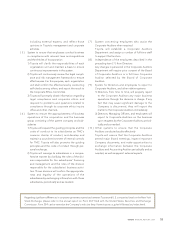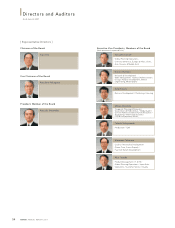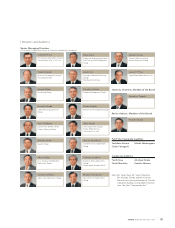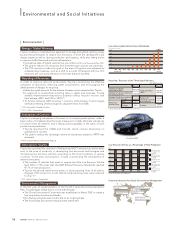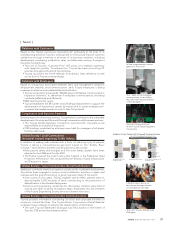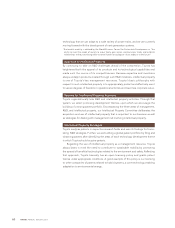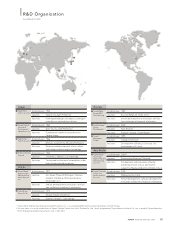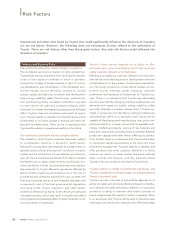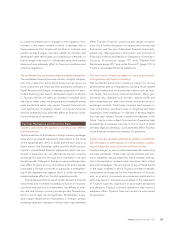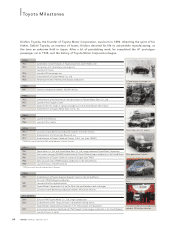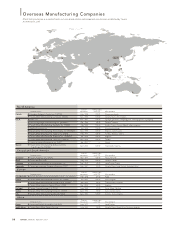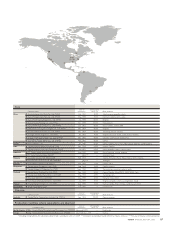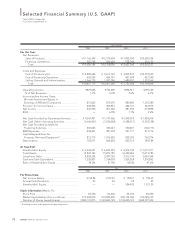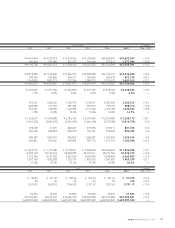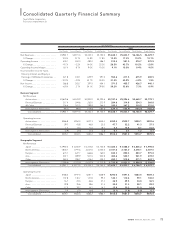Toyota 2007 Annual Report Download - page 65
Download and view the complete annual report
Please find page 65 of the 2007 Toyota annual report below. You can navigate through the pages in the report by either clicking on the pages listed below, or by using the keyword search tool below to find specific information within the annual report.
ANNUAL REPORT 2007 63
to customer preferences or changes in the regulatory envi-
ronment in the major markets in which it operates. Nor is
there assurance that Toyota will be able to cultivate and
protect its brand image. Toyota’s inability to maintain well
developed sales techniques and distribution networks or
brand image may result in decreased sales and market
share and may adversely affect its financial conditions and
results of operations.
The worldwide financial services industry is highly competitive.
The worldwide financial services industry is highly competi-
tive. The market for automobile financing has grown as
more consumers are financing their purchases, primarily in
North America and Europe. Increased competition in auto-
mobile financing may lead to decreased margins. A decline
in Toyota’s vehicle unit sales, an increase in residual value
risk due to lower used vehicle price and increased funding
costs are factors which may impact Toyota’s financial ser-
vices operations. A negative impact on Toyota’s financial
services operations may adversely affect its financial condi-
tions and results of operations.
Political, Regulatory and Economic Risks
Toyota’s operations are subject to currency and interest
rate fluctuations.
Toyota is sensitive to fluctuations in foreign currency exchange
rates and is principally exposed to fluctuations in the value
of the Japanese yen, the U.S. dollar and the euro and, to a
lesser extent, the Australian dollar and the British pound.
Toyota’s consolidated financial statements, which are pre-
sented in Japanese yen, are affected by foreign currency
exchange fluctuations through both translation risk and
transaction risk. Changes in foreign currency exchange rates
may affect Toyota’s pricing of products sold and materials
purchased in foreign currencies. In particular, a strengthen-
ing of the Japanese yen against the U.S. dollar can have a
material adverse effect on Toyota’s operating results.
Toyota believes that its use of certain derivative financial
instruments and increased localized production of its prod-
ucts have reduced, but not eliminated, the effects of inter-
est rate and foreign currency exchange rate fluctuations,
which in some years can be significant. Nonetheless, a neg-
ative impact resulting from fluctuations in foreign currency
exchange rates and changes in interest rates may adversely
affect Toyota’s financial conditions and results of opera-
tions. For a further discussion of currency and interest rate
fluctuations and the use of derivative financial instruments,
please see “Management’s Discussion and Analysis of
Financial Condition and Results of Operations—Overview—
Currency Fluctuations (page 77)” and “Market Risk
Disclosures (page 92),” and notes 20 and 21 (page 121) to
Toyota’s consolidated financial statements.
The automotive industry is subject to various governmen-
tal regulations and legal proceedings.
The worldwide automotive industry is subject to various
governmental laws and regulations including those related
to vehicle safety and environmental matters such as emis-
sion levels, fuel economy, noise and pollution. Many gov-
ernments also regulate local content, impose tariffs and
other trade barriers, taxes and levies, and enact price or
exchange controls. Toyota has incurred, and expects to
incur in the future, significant costs in complying with these
regulations. New legislation or changes in existing legisla-
tion may also subject Toyota to additional expense in the
future. Toyota is also subject to a number of pending legal
proceedings. A negative outcome in one or more of these
pending legal proceedings could adversely affect Toyota’s
future financial conditions and results of operations.
Toyota may be adversely affected by political instabilities,
fuel shortages or interruptions in transportation systems,
natural calamities, wars, terrorism and labor strikes.
Toyota is subject to various risks associated with conducting
business worldwide. These risks include political and eco-
nomic instability, natural calamities, fuel shortages, interrup-
tion in transportation systems, wars, terrorisms, labor strikes
and work stoppages. The occurrence of any of these events
in the major markets in which Toyota purchases materials,
components and supplies for the manufacture of its prod-
ucts, or in which its products are produced, distributed or
sold, may result in disruptions and delays in the operations
of Toyota’s business. Significant or prolonged disruptions
and delays in Toyota’s business operations may result to
adversely affect Toyota’s financial conditions and results
of operations.


